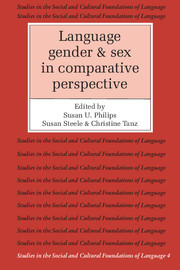Book contents
- Frontmatter
- Contents
- Acknowledgments
- List of contributors
- Introduction: The interaction of social and biological processes in women's and men's speech
- Part I Women's and men's speech in cross-cultural perspective
- Introduction
- 1 The womanly woman: manipulation of stereotypical and nonstereotypical features of Japanese female speech
- 2 The impact of stratification and socialization on men's and women's speech in Western Samoa
- 3 The interaction of variable syntax and discourse structure in women's and men's speech
- 4 A diversity of voices: men's and women's speech in ethnographic perspective
- 5 Women's speech in modern Mexicano
- Part II Gender differences in the language of children
- Part III Sex differences in language and the brain
- References
- Index
Introduction
Published online by Cambridge University Press: 05 June 2012
- Frontmatter
- Contents
- Acknowledgments
- List of contributors
- Introduction: The interaction of social and biological processes in women's and men's speech
- Part I Women's and men's speech in cross-cultural perspective
- Introduction
- 1 The womanly woman: manipulation of stereotypical and nonstereotypical features of Japanese female speech
- 2 The impact of stratification and socialization on men's and women's speech in Western Samoa
- 3 The interaction of variable syntax and discourse structure in women's and men's speech
- 4 A diversity of voices: men's and women's speech in ethnographic perspective
- 5 Women's speech in modern Mexicano
- Part II Gender differences in the language of children
- Part III Sex differences in language and the brain
- References
- Index
Summary
The purpose of Part I of this book is to consider the ways in which women's and men's speech are similar and different in different languages and societies. Five languages and societies are treated in the chapters that make up this section: Japanese as spoken in Japan, Samoan as spoken in Western Samoa, English as spoken in the United States, Kuna as spoken by the Kuna Indians of Panama, and Mexicano as spoken by the Nahuatl Indians of Mexico.
Since the mid-1970s the bulk of the many studies of sex differences and language that have appeared in print have focused on sex differences in our own society, particularly on sex differences in language use associated with the possession or lack of power and authority (Lakoff, 1975) in the use of hedges and tag questions. As we shall see in this group of chapters, however, the nature of the society in which biological males and females sustain themselves as social men and women and the structure of the language they speak significantly affect the kinds of gender differences in language function and form that can be discussed and the ways in which they can be discussed.
A comparative view of gender differences in language form has existed within linguistic study since the early part of this century. Sapir's 1915 paper “Abnormal Types of Speech in Nootka” (E. Sapir, 1915) focuses on linguistic devices that imply something about the social identity of the speaker, devices he characterizes as “person implications.”
- Type
- Chapter
- Information
- Language, Gender, and Sex in Comparative Perspective , pp. 15 - 25Publisher: Cambridge University PressPrint publication year: 1987
- 3
- Cited by



